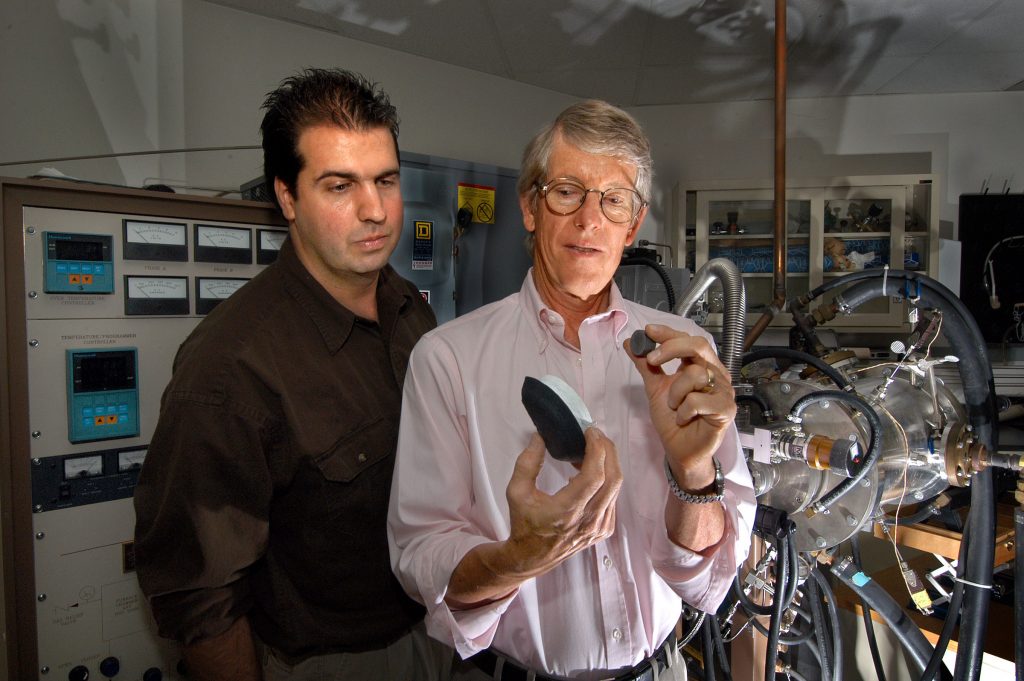
ALBUQUERQUE, N.M. — Researchers at the Department of Energy’s Sandia National Laboratories have developed a new lightweight material to withstand ultra-high temperatures on hypersonic vehicles, such as the space shuttle.
The ultra-high-temperature ceramics (UHTCs), created in Sandia’s Advanced Materials Laboratory, can withstand up to 2000ºC (about 3,800ºF).
Ron Loehman, a senior scientist in Sandia’s Ceramic Materials, said results from the first seven months of the project have exceeded his expectations.
“We plan to have demonstrated successful performance at the lab scale in another year with scale-up the next year,” Loehman said.
Thermal insulation materials for sharp leading edges on hypersonic vehicles must be stable at very high temperatures (near 2000ºC). The materials must resist evaporation, erosion, and oxidation, and should exhibit low thermal diffusivity to limit heat transfer to support structures.
Composite materials
UHTCs are composed of zirconium diboride (ZrB2) and hafnium diboride (HfB2), and composites of those ceramics with silicon carbide (SiC). These ceramics are extremely hard and have high melting temperatures (3245ºC for ZrB2 and 3380ºC for HfB2). When combined, the material forms protective, oxidation-resistant coatings, and has low vapor pressures at potential use temperatures.
“However, in their present state of development, UHTCs have exhibited poor strength and thermal shock behavior, a deficiency that has been attributed to inability to make them as fully dense ceramics with good microstructures,” Loehman said.
Loehman said the initial evaluation of UHTC specimens provided by the NASA Thermal Protection Branch about a year ago suggests that the poor properties were due to agglomerates, inhomogeneities, and grain boundary impurities, all of which could be traced to errors in ceramic processing.
During the first seven months, the researchers made UHTCs in both the ZrB2 and HfB2 systems that are 100 percent dense or nearly so. They have favorable microstructures, as indicated by preliminary electron microscopic examination. In addition, the researchers have hot pressed UHTCs with a much wider range of SiC contents than ever before. Availability of a range of compositions and microstructures will give system engineers added flexibility in optimizing their designs.
Collaborations
The project is part of the Sandia Thermal Protection Materials Program and represents the work of several Sandia researchers. The primary research team consists of Jill Glass, Paul Kotula, David Kuntz, and University of New Mexico doctoral student Hans-Peter Dumm.
Kuntz said his primary responsibility is to compute aeroheating, design thermal protection systems (heat shields), compute material thermal response on high-speed flight vehicles, and to develop tools to improve these capabilities.
“If a vehicle flies fast enough to get hot, we analyze it,” Kuntz said. “Our tools consist of a set of computer codes that compute the flowfield around a high-speed flight vehicle, the resultant heating on the surface of the vehicle, and the subsequent temperatures and ablation of the materials which form the surface of the vehicle.”
Glass works with high-temperature mechanical properties and fracture analysis, and Kotula performs microstructural and microchemical analysis on the ceramic materials.
Kotula applies the Automated eXpert Spectral Image Analysis (AXSIA) software (developed by Kotula and Michael Keenan, and recently patented and winner of a 2002 R&D 100 award) to the characterization of hafnium and zirconium diboride/silicon carbide UHTCs. Kotula looks at these materials at the micron to subnanometer length scale for grain size and phase distribution as well as impurities or contaminants that can adversely affect their mechanical properties.
Creative analysis
Boron and carbon are difficult to analyze because they give off low-energy or soft X-rays when excited with an electron beam as in a scanning or transmission electron microscope typically used for such analyses. Instead of using X-ray analysis techniques, the research team has developed other analytical capabilities based on electron energy-loss spectrometry to determine amounts and nanometer-scale lateral distributions of the light elements in the UHTCs.
Oxygen, in particular, is an important impurity since, in combination with the silicon present in the UHTCs and other impurities, it can form glasses or other phases that typically can?t take the required high-operation temperatures and would melt or crack in service, causing the material to fail.
“If enough of the wrong contaminants find their way into the process, the material will have no high-temperature strength or stability,” Kotula said.
Sandia technical contact: Ron Loehman, loehman@sandia.gov , (505) 272-7601
